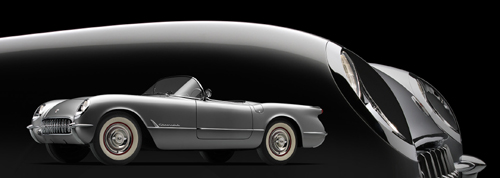
While 1954 Corvettes are far from ordinary, VIN #2771 of 3640 produced in the second year of Corvette production took the path that few Corvettes seldom see and has survived to tell the tale 54 years later. This Corvette would become part of an exclusive club known as “style” Corvettes. Style Corvettes were cars usually pulled off the assembly line and sent to GM’s design studios where they would undergo a host of interior and exterior design changes as Chevrolet looked to improve and refine the looks, comfort and usability of the two-seat sports car.
The life span of a “style” Corvette was usually short. It was common for these cars to be destroyed after their “styling” exercises were concluded, but in some instances they were returned as close as stock as possible and resold. In some rare cases, they were kept in their restyled configuration and sold to GM employees or outsiders with ties to the Corvette program
Yet E54S002771 wasn’t pulled from the assembly line like the typical style Corvette. She started out the way most 2nd year Corvettes did – delivered to her new owner with a factory fresh Polo White enamel exterior with Sportsman Red interior. The original owner of #2771 was a GM employee named Roger Crispel. Roger longed for a 1953 Corvette, but being neither a VIP nor a celebrity, the two credentials needed to secure 1 of the 300 Corvettes built in that first year, had to settle on a 1954 model.
Roger received his Corvette in the middle of 1954 and thoroughly enjoyed the car until he started having issues with the mechanicals and the top. His Chevrolet dealer was powerless to help and may have actually contributed to Roger’s problems as at one point the Corvette wouldn’t go any faster than 15 mph. Copies of letters exist today show Roger wrote to Chevrolet Chief Engineer Ed Cole, describing his issues with his 1954 Corvette and how his euphoria and enthusiasm for the car had turned to dismay. Cole suggested dropping off the car at GM’s executive garage and Roger was given use of a company car while the mechanical problems could be correctly diagnosed and fixed. GM performance contributor and 3-time Indy 500 winner Mauri Rose signed off on the engine performance once the repairs were completed. Fitted with the second generation top now found on 1955 Corvettes, the Corvette was reunited with her owner.
In 1955 Roger was leading one of GM’s various interior design studios and needed a Corvette for a proposal. Instead of requesting a Corvette off the assembly line, he offered up his own car for the exercise. The first design exercise for #2771 was Shop Order 2536 and was dated 4-14-55. That exercise had the Corvette painted orange and black. “Hideous” is the word that Roger used to describe the appearance of his Corvette at the conclusion of the study.
A second Corvette design proposal was floated a few months later and once again Roger offered up his own 1954 Corvette as the subject. This exercise was Shop Order 10028 and was dated 2-11-56. The Corvette was repainted in a finish that Roger himself created. The color was described as having a goldish-silver hue and so he named it “Sahara Silver”. The interior was redone in a two-tone black and silver alligator leather trim and the original beige top was replaced with black canvas which really complimented the silver exterior and black and silver interior. Other styling enhancements included an engine-turned gauge bezel, a prototype three spoke Corvette steering wheel, vertical “shark-fin” headlamp fittings and a center armrest storage console.
The “shark-fin” headlamp fittings are one of the more interesting aspects of the second design proposal. 1953-1955 Corvettes are well known for their wire-mesh basket headlight covers, but due to laws in several states that prohibited obstruction of the headlights, the vertical shark-fin was tested as an alternative to the production headlamp baskets. In the end only two sets were made with one set installed on this 1954 Corvette while the other set found its way to GM Design Chief Chuck Jordan’s own Corvette.
The details of the two separate style exercises were well documented as Roger kept fastidious records. The 2-inch GM binder retained with the Corvette details the progress of the design proposals and numerous photos show the corvette undergoing the work in GM’s design shops. The Corvette itself is documented with the shop order (SO) id and date stamped on a metal plate that was then riveted to the Corvette’s cowl.
Sometime in the early Seventies, the Corvette was sold to Bruce Vollmer who restored the Corvette back to its original Polo White with Sportsman Red interior. The custom parts like the shark-fin headlamp splitters, dash, steering wheel and top all remained on the car. Shortly after this restoration, #2771 was parked in a heated garage where it remained for 30 years. Family, work, and money are often the reasons why cars are parked and forgotten and such was the case with this 1954 Corvette Roadster.
Corvette restorer Werner Meier knew #2771’s second owner Bruce Vollmer and had seen the Corvette in person. He had also seen the two-inch binder that documented her time in GM’s design studios. Knowing the special history of the Corvette, Werner often tried to convince Bruce to let him restore the car, but to no avail. Finally, the time was right and the Corvette was sold to well known automotive collector Ken Lingenfelter (no relation to John), who had the car transported to Werner’s Masterworks Automotive Services in Madison Heights, Michigan for restoration.
Werner used the data and pictures from the second design exercise as the basis of the restoration and the results of his eight months of labor are stunning. Much of the chrome had to be redone and Werner concentrated much of his talents on improving the fit and finish of the panels and gaps that early Corvettes are notoriously known for. Werner also had to take special care when working on the car’s custom pieces like the “shark-fin” headlight splitters. They were showing deterioration when he received the car and should anything have happened to them during the restoration process, there was no supplier call to order a new set.
The future of #2771 remains to be written, but looks to be much brighter since becoming one of the cornerstones of Ken Lingenfelter’s 150 car collection. Ken recently shared this Corvette and several others as E54S002771 made her public debut at the NCRS Michigan Regional Meet in Novi in Mid May 2008.
For a pricing perspective we turned to Vette-N-Vestment’s Bob Kroupa who said that documented style Corvettes are very rare and when they do reach the open market, they usually sell for a premium price. Bob mentioned the recent sale of two style Corvettes that were sold during 2006’s Bloomington Gold auction as a comparison. Both were owned by the former President of Chevrolet Bunkie Knudsen. A pink 1964 automatic coupe with air that was styled for his wife sold to collector Bob McDorman for $367,500 while Mike Yager of Mid America snatched up Bunkies personal frost blue 1964 Coupe for $278,250.
Source:
Masterworks Automotive Services
Corvette Forum
Photo Credits
Al Steiger – North Oaks Corvette Club
James Haefner – Haefner Photo
John Hinckley – Michigan NCRS
Related:
Friday’s Featured Corvettes for Sale – 1954 Edition
Rare 1957 “Airbox” Corvette Found & Restored to Former Glory
-

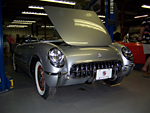
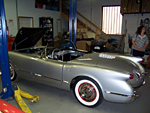
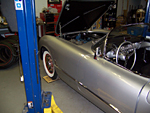
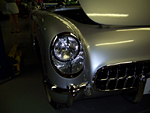

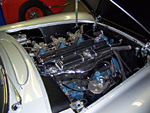
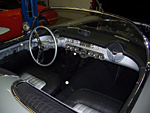
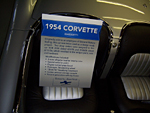
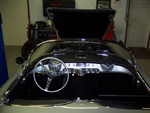
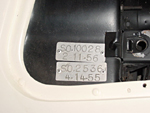
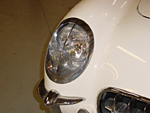
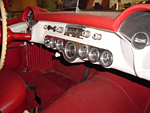



Thanks for this story, as it gives us insight into the Corvette evolutionary developmental process inside GM.
Bill from CorvetteBlog.com
Bill:
Thanks for stopping by. Good to hear from you as always.
Keith
Comments are closed.